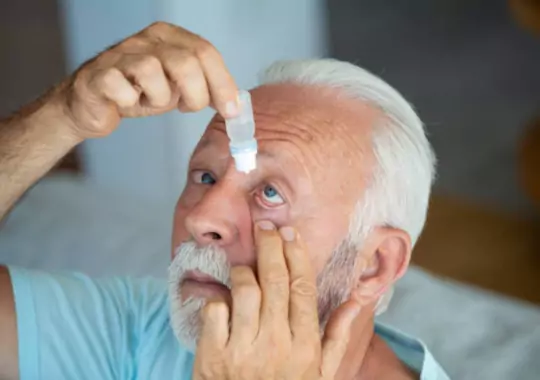As Amazon affiliates we may earn a commission if you purchase a product at no cost to you.
Do your eyes often feel like they're on fire? The discomfort of burning eyes is not only irritating but can also signal underlying issues that require attention. In this article, we delve into the causes of burning eyes and explore potential solutions to alleviate the discomfort. Let's unravel the mysteries surrounding this common eye ailment.
Understanding Burning Eyes
Burning eyes manifest as a stinging and gritty sensation, often accompanied by redness, puffiness, itching, and discharge. These symptoms can be indicative of various underlying conditions that demand a closer look.
Causes of Burning Eyes
Blepharitis:
One potential culprit behind burning eyes is blepharitis, characterized by the inflammation of eyelids due to a clogged oil gland. Symptoms include watery eyes, flaky skin around the eyes, itchy eyelids, and sensitivity to light.
Symptoms of Blepharitis: Recognizing the Signs
Watery Eyes: Excessive tearing or watery eyes are a common manifestation of blepharitis. The inflammation disrupts the normal tear production and drainage process, leading to increased moisture in the eyes.
Flaky Skin Around the Eyes: The presence of flaky, irritated skin surrounding the eyes is another characteristic symptom. This can contribute to a gritty sensation and further exacerbate the discomfort associated with burning eyes.
Itchy Eyelids: Persistent itching of the eyelids is a telltale sign of blepharitis. The inflammation and compromised oil gland function contribute to the itching sensation, prompting individuals to rub their eyes frequently.
Sensitivity to Light: Blepharitis often induces sensitivity to light, a condition known as photophobia. This can intensify the discomfort experienced in brightly lit environments.
Addressing Blepharitis with Specialized Eye Drops
When it comes to managing blepharitis-induced burning eyes, specialized eye drops play a pivotal role in alleviating symptoms and promoting healing. These eye drops are formulated to address the underlying issues associated with this condition.
Prescription Antibiotics for Bacterial Infections: In cases where blepharitis is caused by bacterial infections, prescription antibiotics in the form of eye drops are commonly prescribed. These targeted medications help combat the bacterial overgrowth responsible for the inflammation.
Steroid Eye Drops for Inflammation and Itching: The use of steroid eye drops proves effective in reducing inflammation and alleviating itching associated with blepharitis. These drops work to suppress the immune response, providing relief from discomfort.
Comprehensive Care for Lasting Relief
While addressing the symptoms with specialized eye drops is crucial, comprehensive care is equally important for lasting relief from blepharitis-induced burning eyes. This may involve a combination of at-home remedies, such as warm compresses and gentle eyelid hygiene practices, in conjunction with prescribed medications.

Dry Eyes:
Insufficient lubrication leads to dry eyes, causing not only burning but also sensitivity to light, eye fatigue, redness, and mucus around the eyes. Factors like allergies, wind, smoke exposure, computer use, arthritis, or certain medications can trigger this discomfort.
Symptoms of Dry Eyes: Beyond the Burning Sensation
Burning Sensation: The hallmark symptom of dry eyes is a persistent burning sensation. This discomfort is a result of the eyes' struggle to maintain proper moisture levels, leading to increased friction with every blink.
Sensitivity to Light: Dry eyes often coincide with heightened sensitivity to light, a condition known as photophobia. This exacerbates the discomfort experienced in brightly lit environments, making it challenging for individuals to endure prolonged exposure.
Eye Fatigue: The constant effort required for blinking and compensating for the lack of lubrication can lead to eye fatigue. Individuals with dry eyes may find their eyes tiring quickly, especially during activities that demand sustained visual focus.
Redness: Insufficient lubrication can cause redness in the eyes, further intensifying the visual discomfort. The blood vessels in the eyes may become more prominent, contributing to the overall red appearance.
Mucus Around the Eyes: Dry eyes can result in the production of excessive mucus, leading to a sticky or stringy sensation around the eyes. This adds an additional layer of discomfort and hampers the natural lubrication process.
Triggers for Dry Eyes: Identifying Contributing Factors
Several factors can contribute to the development of dry eyes, extending beyond the obvious lack of lubrication. Understanding these triggers is crucial for both prevention and targeted treatment. Common contributors include:
- Allergies: Allergic reactions can disrupt the normal tear film and contribute to dry eyes.
- Environmental Factors: Wind, smoke exposure, and extended periods of computer use can exacerbate dry eyes.
- Systemic Conditions: Conditions such as arthritis may impact tear production, leading to dry eyes.
- Medications: Certain medications, including antihistamines and antidepressants, can contribute to dry eyes as a side effect.
Addressing Dry Eyes with Specialized Eye Drops
When it comes to managing dry eyes, specialized eye drops tailored to the specific needs of the individual become instrumental in providing relief. These eye drops aim to restore moisture, alleviate symptoms, and promote overall eye health.
Artificial Tears for Lubrication: Artificial tear eye drops , mimicking the composition of natural tears, serve as a primary intervention for dry eyes. They provide immediate relief by lubricating the eyes and addressing the underlying dryness.
Prescription Medications for Chronic Cases: In instances of chronic dry eyes, prescription medications in the form of eye drops may be recommended. These medications work to stimulate tear production or reduce inflammation, targeting the root cause of the dryness.
Comprehensive Management for Long-Term Relief
While specialized eye drops are crucial for managing the symptoms of dry eyes, a comprehensive approach is essential for sustained relief. This may include lifestyle adjustments, environmental modifications, and ongoing eye care practices to address the underlying factors contributing to dry eyes. Check out the best eyedrops for burning eyes on Amazon.
LUMIFY Redness Reliever Eye Drops.
Systane Ultra PF Preservative-Free Eye Drops.
Biotrue Hydration Boost Eye Drops.
Clear Eyes Cooling Comfort Relief Eye Drops.

Allergies:
Eye allergies induced by smoke, dust, pollen, and dander can result in burning eyes, accompanied by other allergy symptoms like watery eyes, sneezing, coughing, a runny nose, and a sore throat.
Symptoms of Eye Allergies: Beyond the Burning Discomfort
Burning Eyes: The primary symptom, a burning sensation in the eyes, results from the immune system's response to allergens. This discomfort is an immediate indicator of the eyes' sensitivity to specific triggers.
Watery Eyes: Excessive tearing or watery eyes are a common reaction to eye allergies. The increased tear production is the body's attempt to flush out the irritants causing the allergic response.
Sneezing and Coughing: Eye allergies often coincide with respiratory symptoms, including sneezing and coughing. These reactions are part of the body's effort to expel allergens and alleviate the overall allergic response.
Runny Nose: Nasal congestion and a runny nose are frequent companions to eye allergies. The inflammation triggered by allergens can extend to the nasal passages, contributing to these symptoms.
Sore Throat: Irritation from postnasal drip, a common consequence of eye allergies, can lead to a sore throat. This symptom further underscores the interconnected nature of allergy symptoms.
Identifying Allergens: Unveiling Common Triggers
Understanding the specific allergens responsible for eye allergies is crucial for both prevention and targeted treatment. Common triggers include:
- Smoke: Inhalation of smoke, whether from tobacco or environmental sources, can exacerbate eye allergies.
- Dust: Particles in the air, including dust mites and other airborne particles, can trigger allergic reactions in the eyes.
- Pollen: Pollen from trees, grasses, and flowers is a prevalent allergen that can induce eye allergies, particularly during specific seasons.
- Dander: Pet dander, often present in the fur or feathers of animals, can contribute to allergic responses in the eyes.
Specialized Eye Drops for Allergy Relief
Addressing burning eyes due to allergies necessitates targeted interventions, with specialized eye drops serving as a key component of the treatment plan. These eye drops are formulated to alleviate symptoms and provide relief from the allergic response.
Antihistamine Eye Drops: Antihistamine eye drops work by blocking the effects of histamine, a key player in allergic reactions. These drops help reduce itching, redness, and the burning sensation associated with eye allergies.
Mast Cell Stabilizers: Eye drops containing mast cell stabilizers prevent the release of histamine and other allergic mediators, offering long-term relief from allergy symptoms.
Combination Eye Drops: Some formulations combine antihistamines and mast cell stabilizers for a comprehensive approach to addressing both immediate and long-term allergy symptoms.
Recommended Article

Frequently Asked Questions FAQs
Can over-the-counter eye drops help with burning eyes?
Over-the-counter eye drops can provide relief for burning eyes, especially if the cause is dryness or allergies. However, it's essential to choose the right type of eye drops based on your specific symptoms and consult an eye care professional if the discomfort persists.
Are there any side effects associated with eye drops for burning eyes?
While most eye drops are safe when used as directed, some may have side effects or contraindications. It's important to follow the instructions on the packaging and consult with a healthcare provider or eye specialist if you have concerns about using eye drops.
Conclusion
In conclusion, understanding the intricacies of burning eyes goes beyond recognizing the immediate discomfort. With a focus on pinpointing the cause and seeking appropriate treatment, relief becomes not just a possibility but a tangible outcome. For those grappling with burning eyes, the use of specialized eye drops tailored to the underlying issue can play a pivotal role in the journey towards clearer, more comfortable vision.










